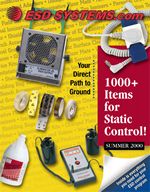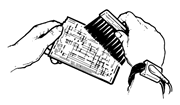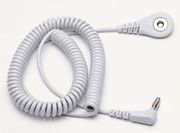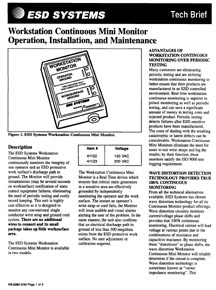 |
| ESD Technical e-Newsletter |
|

|
June 2000
Issue 6, Volume 3
|
|
CLEANROOMS & ESD
| |
ONCE UPON A TIME,IN AN INQUIRY LONG, LONG AGO. FROM A COMPANY FAR, FAR, AWAY WE WERE ASKED IF OUR PRODUCTS WERE APPROVED FOR USE IN THEIR CLEANROOM. OUR RESPONSE WAS AND IS "DO YOU HAVE TO COMPLY WITH A CERTAIN SPEC?" AND THE ANSWER WAS, IS, AND WILL ALWAYS BE.. "I DON'T KNOW"
No Standard Acceptance Criteria
Users Products and Processes Vary Significantly
What Concerns a Particular User May Not Worry Another
40,000 Cleanrooms ==> 40,000 Approval Processes
Organizations
SEMI - Semiconductor Equipment and Materials International, Headquarters in Mountain View, CA
IDEMA - International Disk Drive and Materials Association, Headquarters in Santa Clara, CA
IEST - Institute of Environmental Sciences and Technology
NASA (Those Space guys)
MILITARY (Those Bomb Guys)
Standards (A Few of the Many)
MIL STD - 1246C Product cleanliness levels and contamination control program
FED STD 209E ===> ISO 209 Airborne particulate cleanliness classes in Cleanrooms and clean zones (see chart below)
SEMI, E78-0998 Electrostatic Compatibility Guide And Control Electrostatic
Discharge And Electrostatic Attraction For Equipment
ASTM E595-93 Standard Test Method for Total Mass Loss and Collected Volatile Condensable Materials from Outgassing in a Vacuum Environment
IEST - RP's (Recommended Practices)
| Class Limits for Federal Standard 209E
|
|
SI
|
Class
|
0.1
|
0.2
|
0.3
|
0.5
|
5
|
| M 1.5 |
1 |
35 |
7 |
3 |
1 |
0 |
| M 2.5 |
10 |
350 |
75 |
30 |
10 |
0 |
| M 3.5 |
100 |
N/A |
750 |
300 |
100 |
0 |
| M 4.5 |
1000 |
N/A |
N/A |
N/A |
1,000 |
7 |
| M 5.5 |
10000 |
N/A |
N/A |
N/A |
10,000 |
70 |
| M 6.5 |
100000 |
N/A |
N/A |
N/A |
100,000 |
700 |
|
Testing
Particulate Testing (liquid or air extraction) - $125/test
Non-Volatile Residue (solvent extraction) - $165/test
Volatile Organic Compounds (ion extractables) -
Ionic Contamination - $900 Contamination testing to include one isothermal TGA run, gravimetric non-volatile residue with FTIR evaluation, ion chromatography analysis for ionic levels
Labs
River's Edge Technical Service - Carl Newberg
Research Triangle Institute - Liz Hill
Types of Products
Clean Products Produced and Packaged in Clean Environment
Standard Products Produced in Standard Environment Cleanable To Required Level
Our products that may be cleanable to required levels
|
|
|
|
New Catalog Coming Soon!
Don't forget to request your new catalog from our on-line catalog request form by clicking here. You can also visit our on-line catalog at anytime by clicking here.

|
|
Antistatic and Dissipative Brushes

Our antistatic brushes are made from low charging materials and natural materials that are near neutral on the triboelectric chart. They neither give nor take electrons and, therefore, remain essentially electrically neutral. There can, however, be a slight charge created. In extreme voltage sensitive applications, these brushes should be used only in a liquid environment.
Item # 34118 & 34120 dissipative brushes have a surface resistivity of 105 - 1011 ohms, a higher resistivity than the conductive brushes, but sufficiently conductive to preclude any static build up in the brush. These are excellent tools to use in removing any static charge that will result in the adhesion of particles, such as dust, to an object. Frequent use of these brushes will keep electrostatic charges from building up on your products. Please use these brushes with a wrist strap or other mechanism to provide a path to ground for safety.
Click here to view the Brush Tech Bulletin TB-34108
|
|
|

Ready for something exciting? Look on page 13 of our catalog. See the grey coil cords? We are now referring to this as our Rapid Retraction coil cord. That's not the exciting part. What is exciting is that this coil cord has now crossed the 20 million flex cycles point with no failures and is still flexing!
Now that's exciting! The best "black" Coil Cords on the market today only average 1,000,000 flex cycles. This is 1,250 times better than what the ESD Association Standard ESD S1.1 calls for. Ready for some more excitement? This cord is now available with a Right Angle Banana.
The Right Angle Banana decreases the profile of the cord as it extends from the banana ground socket, less chance to snag on something.
The Right Angle Banana design decreases the chance for the banana to be pulled from the ground socket.
The Right Angle Banana design reduces flex at this end of the coil cord, thus helping to increase the life of the coil cord . . . AS IF 20,000,000 FLEX CYCLES WASN'T ENOUGH!
This Rapid Retraction coil cord has a higher "memory" than other coil cords, thus it reduces "dragging" and "tangling".
|
|
|
22nd Annual International EOS/ESD Symposium and Exhibits
Click here for more EOS/ESD Symposium Info or the EOS/ESD Symposium Program
September 24-28, 2000 at Disneyland Hotel, Anaheim, CA USA
- "ESD Workshops" dozens of Technical Seminars
- "ESD Exhibits" visit us at our Booth, # 202
- "ESD NARTE Certification" become NARTE certified!
- ESD Technical Paper Presentations
|

Sponsored by
|
|
|
|
|
Q1: We have a class 10,000 clean tent in which we will be building an instrument that will go into space. The instrument is optical, and is susceptible to particulates and outgassing.
Large amounts of electronics are also involved. I need to know what the best material is for cleanroom and static dissipative applications. - Anonymous, Boulder, CO see ANSWER 61
Q2: I have read about class 100 Cleanrooms, class 10000 tents, class zero work benches, etc. Where can I find out more about these standards, and who sets them? Does certification to a given standard involve actual electrical measurement, or just an assessment of the ESD practices and equipment in use? Can you just declare your compliance, or is outside certification required? - Fletcher , Auckland, New Zealand see ANSWER 143
Q3: Is there a standard, a good book or an article, which could be used as a guide to improve ESD control in semiconductor fabrication (wafer fabrication in cleanroom)? - Anonymous, Espoo, Finland see ANSWER 324
|
|
|
|
NOTE:
If you haven't already done so, downloading Acrobat Reader is highly recommended as most of our Technical Literature is in an electronic form known as portable document files (PDF files). These can be e-mailed or downloaded from our website, however you'll need Adobe Acrobat Reader to view them.
The good news is that this program is free. Adobe Acrobat can be downloaded from Adobe's website, The file is over 3 megs, so be sure you have the capacity to receive that large a file.
|
|
|
|
Our products come will full technical support
Product document support includes a technical brief, drawing or bulletin. These are referenced within our on-line catalog as well as listed in our web site. |

|
|
|
|
|
|
ESD Systems highly recommends wearing 2 foot grounders, one on each foot, to increase the integrity of the body-to-ground connection. Wearing a foot grounder on each foot ensures contact with ground via the ESD Floor even when 1 foot is lifted off the floor. This will more reliably remove static charges generated by human movement, and more reliably protect ESDS devices.
For enhanced safety from operator accidental contact with equipment line voltage, we recommend using foot grounders with 2 megohm resistors. Underwriters Laboratories and OSHA recommend a minimum of 1 megohm resistance to ground (RTG) in order to limit electrical current exposure to a maximum of 0.00025 amperes. When an operator, while wearing 2 one megohm foot grounders, lifts his/her foot off the floor, the resistance to ground (RTG) is 1 megohm. But with both feet grounded, the operator's combined RTG, in parallel, is only ½ megohm. That is, the wearer's equivalent resistance is halved and he/she may be at risk by being grounded with less than 1 megohm resistance to ground in case of contact to 120 or 250 VAC line voltage.
By wearing two Foot Grounders each with a 2 megohm resistor in series to ground, operators are better protected, complying with the UL and OHSA recommendations at all times. The operator's RTG is 2 megohms only when one foot is grounded (in contact with an ESD floor), and they do meet the minimum recommended resistance of 1 megohm RTG when both feet are grounded due to the equivalent resistance of 2 megohms in parallel.
All ESD Systems.com's Foot Grounding items with resistors have been tested by Underwriters Laboratories, and are UL listed.
|
|
|
|
This is a free monthly e-newsletter, which specializes on issues in static control in the semiconductor/electronics workplace and is best viewed while connected to the Internet.
Let us know what you think. Tell us what you would like to see in future issues. Want to contribute articles or other related information to our Newsletter? If you have any comments, suggestions or feedback about this newsletter, please send them directly to the editor@esdsystems.com, thanks.
|
|
|
Copyright © 2000 ESD Systems.com. All rights reserved.
|
|